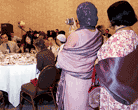Comment on this article
Frosh and Top Profs Meet in Seminars
by Alejandra O'Leary '04
January/February 2005
At 9:13 a.m. in Berkeley College’s Swiss Room, a dark-paneled space with low lighting and long tables, a group of freshmen respond to rapid-fire questions probing the intricacies of slavery in colonial America. Their inquisitor is Jon Butler, dean of the Graduate School and a renowned scholar of American history and religion. Their only resources are the primary-source texts in front of them and trays loaded with breakfast, which Butler allows them to eat quietly in class. The class is called “Revolutionary America,” and today’s topic is the experience of Native Americans and African slaves during the American Revolution. A student notices a detail illustrating the ways in which revolutionaries in America felt themselves “enslaved” by the British crown, and Butler notes that biblically inspired rhetoric about bondage and freedom has informed American oratory ever since the Revolution, flourishing notably during the Civil War.
The course is one of 17 in the freshman seminar program, which allows first-year students to study in intimate classes taught by some of Yale’s most eminent scholars. Although Butler has offered his course to freshmen before, the larger program is new this year—a product of the Yale College curriculum review completed in 2003. (See “Building a Better Yalie,” Yale Alumni Magazine, January 2004.) It complements similar opportunities already available to freshmen, such as Perspectives on Science and the Western civilization-centered Directed Studies.
Besides giving freshmen a unique opportunity to study with Yale’s best, the program also gives faculty members a chance to present their expertise in a new context. “Many instructors describe it as the most exciting teaching they’ve ever done,” says the program’s coordinator, Davenport College dean Peter Quimby. “They get to connect with the vitality and excitement of freshmen.”
Butler emphasizes the intellectual seriousness of his seminar. “It’s a regular course. It just happens to be taught to freshmen,” he says. “It’s tailored to first-year students, but it’s not hokey. It’s not a 'life experience' class. This is a history class.” Other freshman seminars offered this year include “Democracy in America” with political science professor and Branford College master Steven Smith, “German Culture, Arts, and Letters” with German professor Cyrus Hamlin, and “Aztecs of Mexico” with art historian and Saybrook College master Mary Miller.
Mike Schmidt '08 calls “Revolutionary America” his most “student-centered” class this term. “One of the reasons I didn’t do Directed Studies is so that I could take classes like this,” he says.
Like Directed Studies, “Revolutionary America” is writing-intensive. Every other week, Butler’s students must write a 500-word essay that makes an argument about the week’s primary-source reading. “It’s important that they learn to articulate an argument in a short space, using materials they have put together,” says Butler. Schmidt says the class has helped him become more confident in his writing and arguing: “It’s a sophisticated way of looking at history,” he says of Butler’s approach to writing assignments. “Rather than just analyzing what they say, we’re supposed to evaluate what they say.” The term culminates in a 15-page paper using primary-source documents.
Entering freshmen were given a chance to sign up last summer, and the seminars all filled up quickly. Quimby says he hopes to offer 25 freshman seminars next year. Butler takes pride in the program’s success and says he finds his teaching a welcome respite from the hard work of overseeing the Graduate School. But he also sees similarities between his freshman students and graduate students: “It’s the same world. They’re students. Freshmen are just younger. Grad school students still have eyes as big as saucers. For them, it’s still an adventure.”

Surprise exit for VP
by Kate Moran '02
Charles Pagnam, the university’s chief fund-raiser, is a veteran of two major capital campaigns at Yale. Now, as the university readies for another campaign, he says he’s had enough. Pagnam resigned in late October as vice president for development after 27 years at Yale. For the time being, he is serving as a special adviser to President Rick Levin to help cultivate top donors, but he will not stay for the full seven-year campaign. The announcement came as a surprise to most of the university community—and to most of the fund-raising staff, who learned of it just a few days before Pagnam left his position.
Will the departure of the officer in charge of fund-raising affect Yale’s ability to carry out a $2 billion-plus capital campaign? Pagnam says that although his leaving might seem to disrupt the capital campaign in its early stages, bowing out in the middle would create even more of a disturbance.
“Yale has been very good to me and my family. I’ve had an extremely enjoyable professional and personal experience here, but a campaign is a major commitment,” he says. “You’re either in it for the long haul or you’re out.”
Joan O'Neill, an associate vice president for development, will step in for Pagnam while the university searches for a permanent successor. She says Yale will miss Pagnam for his broad knowledge of the university, a quality that made him effective with donors, but she believes the development office has the scaffolding in place to go forward with the capital campaign in his absence.
“If he were leaving a green staff, I think it would be very hard,” O'Neill says. “That’s not to say his departure is easy on all of us, because we value him as an outstanding colleague and mentor and because he carries a lot of institutional knowledge.”
Over the summer, the university reshuffled the development office, elevating O'Neill and Martha Schall, the director of development for the medical school, to associate vice presidents. The change gave them oversight of senior staff and freed Pagnam to focus on key donors during the campaign. Pagnam says it was not an early warning of his departure.
In his time at Yale, Pagnam has served as director of development for individual capital gifts, for the Yale Alumni Fund, and for corporate and foundation relations. Since he assumed the university’s top fund-raising post in January 1998, annual contributions have grown from $203 million to $350 million—a sum that gave Yale top billing in the Chronicle of Higher Education’s recent survey of alumni giving.

Park or parking garage?
by Mark Alden Branch ’86
A little-noticed university storage yard north of Ingalls Rink has become the center of a neighborhood controversy because of Yale’s plans to build a three-level, 350-car parking garage there. The project has won approval from city officials despite opposition from some neighbors on adjacent Mansfield Street—who are concerned about noise, light pollution, traffic, and lowered property values—and faculty at the environment school—who would like to see the lot restored as wetlands.
The garage is being built to satisfy a requirement by the city that Yale provide new structured parking (to replace the parking spaces eliminated by the construction of the new chemistry and engineering buildings on Prospect Street). Associate vice president Michael Morand '87, '93MDiv, says the lot is the best place for the garage and that its siting conforms with the idea that Yale should build on land it already owns whenever possible. “We’re confident that the project is solid and that it fits into its context,” says Morand. “We’re building it literally in our own backyard.”
Michael Curtis '66, '70MArch, who lives across the street from the site, is one of a group of neighbors that is appealing the zoning approvals in court in order to stop the project. “A parking garage is just not appropriate for a residential neighborhood,” says Curtis, a former campus architect at Wesleyan University. “I’m quite certain that Yale has other options.”
Yale officials say they have gone to great lengths to minimize the impact of the garage. Latticework on the façade will soften the structure’s appearance and eliminate the glare of headlights from inside the garage, and one parking level will be partially underground. “The building’s height will be substantially lower than the adjacent rooflines,” says Morand.
Another objection to the plan comes from students and faculty at the School of Forestry and Environmental Studies, who note that the site is a wetland and one of the few remaining open spaces in the area. Gaboury Benoit, a professor at the environment school, advocates reclaiming the stream that runs through the site. “You can put parking anywhere you want,” says Benoit. “You can’t create new green space. There’s a limited amount.” President Rick Levin says that the university does in fact plan to restore the stream and most of the open space and landscape it with paths for public use.
The issue isn’t likely to be resolved soon. The appeal filed by the neighbors may not be decided in court for several months.

Election 2004 By the Numbers
Ward 1, which consists mainly of Yale students:
Kerry 741
Bush 116
Nader 14
Badnarik 8
Cobb 5
Presidential choices of Yale football players, as reported by the Sports Publicity Office shortly before the election:
Bush 62
Kerry 27
Undecided 11
Total contributions over $200 by Yale employees:
To Kerry: $89,961 (143 contributions)
To Bush: $5,000 (4 contributions)
Total contributions by members of Skull and Bones in George Bush’s class ('68):
To Bush: $7,000
Total contributions by members of Skull and Bones in John Kerry’s class ('66—not including Kerry, who gave $25,000 to the DNC*):
To Kerry: $20,500
To DNC*: $250
To Bush: $2,100
To RNC*: $625
Total contributions by members of the Yale Corporation:
To Kerry: $8,000 (5 people)
To DNC*: $34,000 (same 5 people)
To Bush: $4,000 (2 people)
To RNC*: $51,000 (same 2 plus one more)
* DNC: Democratic National Committee; RNC: Republican National Committee
Source for contribution info: www.opensecrets.org
Yale alumni in the 109th Congress
U.S. Senate
Hillary Rodham Clinton '73JD, D-NY
Mark Dayton '69, D-MN
James Jeffords '56, I-VT
John Kerry '66, D-MA
Joseph Lieberman '64, '67LLB, D-CT
C. William Nelson '65, D-FL
Arlen Specter '56LLB, R-PA
U.S. House
Sherrod Brown ’74, D-OH
Lois Capps '64MAR, D-CA
Tom Cole '74MA, R-OK
Sheila Jackson-Lee '72 D-TX
Eleanor Holmes Norton '63MA, '64LLB, D-DC
David Price '64BD, '69PhD, D-NC
Lamar Smith '69, R-TX
John Spratt '69LLB, D-SC
Melvin Watt '70JD, D-NC
David Wu '82JD, D-OR
Former Representative Porter Goss '60 (R-FL) was appointed director of the CIA in August and did not stand for re-election. Representatives Denise Majette '76 (D-GA) and Peter Deutsch '82JD (D-FL) both left their House seats to run, unsuccessfully, for the U.S. Senate.
Yale alumni governors
George Pataki '67, R-NY
Bob Taft '63, R-OH

|




